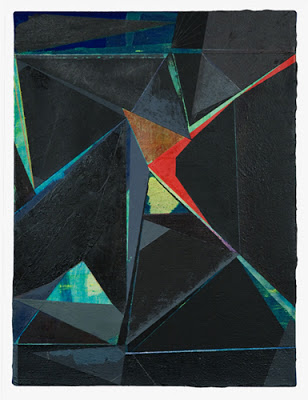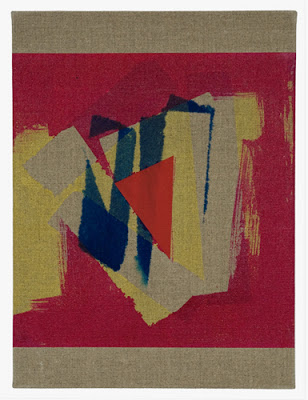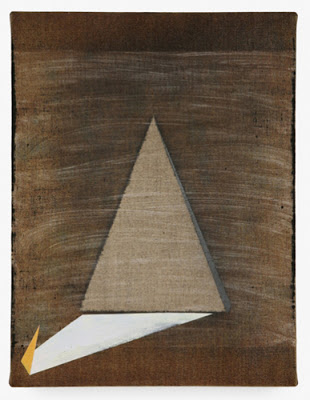Anyone living amid artists who work outside the New York art world can verify that few are looking for a review in the New York Times, a spot in the next Whitney Biennial, or even representation by a commercial gallery. Unaware of (or uninterested in) the larger critical dialogue, they make art for art’s sake, often derivative but well crafted and heartfelt. [See clarification in Comments below.] So when conceptual artist Christopher K. Ho spent a year in Telluride, Colorado, he seemed charmed, perplexed and maybe a little jealous at the absence of critical awareness or self-consciousness among the local artists. In response to his year in the mountains, Ho has put together “Regional Painting (2010),” a thought-provoking interrogation of regional art practice, at Winkleman Gallery.
In ArtForum Nuit Banai suggests that a productive friction emerged from Ho’s engagement with the art community in Telluride, which sparked the creation of fictional artist “Hirsch E. P. Rothko,'” an embittered conceptual artist turned born-again painter. “The show consists of twelve abstract paintings and Hirsch�s acerbic memoir (supposedly ghostwritten by one Inez Kruckev). Overall, it underscores an earnest attempt to carve out an alternative model of criticality by contending with the contemporary meaning of regionalism. After dutifully ingesting all the ‘correct’ critical texts, rubbing elbows with powerful people, teaching at a respected art academy . . . and still not seeing his career flourish in New York City, Rothko decamps to Colorado, lives in a shed covered with license plates, and discovers his passion for painting. Away from the commercial and critical framework of the metropolis, he realizes that regionalism is’ not about a specific look or style’ but operates from a ‘position alongside the main.’ Regionalism�s ‘side-guard’ status, which obeys neither the avant-garde�s imperative for newness nor the rear guard�s for unoriginality, opens up new options.”
At Hyperallergic, Stephen Truax, one of Ho’s former students at RISD, writes that Ho combines two opposing points of view: one, the regional artist who makes art for the sake of art, and two, the self-aware critic/academic who seeks to advance the field. “Before this offering, Ho was merely the latter, and now, he can be both. By deploying a self-deprecating sense of humor, the absurdity of the art school, a love of making, critical theory, and his own unique brand of compulsive attention to detail, Ho manages to hit that sweet spot between regionalism and the international/critical art world. It is not his paintings� ‘lack of pursuit of originality’ (from the press release) that makes them register as a valuable contribution, which would only constitute a purposeful regression or reactionary conservatism. Rather, Ho�s unrelenting analysis of the significance of making art in the present cultural moment, every possible method of making meaning, interpretation, cultural register, signifier or sign, that we find valuable. The center of Ho�s show is not the paintings at all, but the real work of being a conceptual artist in 2010.”
Unfortunately, artists like Ho find thought and analysis so deeply engaging that authentic unmediated experience is beyond their grasp. In the not-too-distant future perhaps we might look back on the ruminative analysis that marks much of the art of our era and wonder whether it was a little too unrelenting.
“Christopher K. Ho: Regional Painting (2010),” Winkleman Gallery, New York, NY. Through December 23, 2010.




















love the last thought … thought and analysis are so deeply engaging that authentic, unmediated experience is beyond their grasp …
and would offer that "thought and analysis" are so often an escapism from actually feeling … and that art is about feeling …
art-talk is a mental disease, carried far enough. 🙂 … just read art forum, see what i mean.
this show made me appreciate other conceptually minded abstract painters so much more (like josh smith)… who make it look so effortless, not belabored, smarter, more of a mind fuck… and make better paintings.
this show was a total clunker i hated it.
"Unaware of (or uninterested in) the larger critical dialogue, they make art for art's sake, often derivative but well crafted and heartfelt."
Oh be wary of sweeping all of "them" into such belittling characterization. The experience of encountering derivative, well-crafted and heartfelt work is pretty common in major art centers as well–even amidst those supposedly steeped in critical awareness. I would add that it is actually not terribly difficult to inhabit rural America, be an artist, AND be critically engaged with the art world thanks to the blogosphere, etc.
Barbara,
By "them" I meant the artists who are NOT interested in being reviewed in the Times, showing in the Biennial, or securing gallery representation. So, yes, there ARE artists who engage critically with the art world from a distance, but I'm talking about a different group–those who don't read the blogs, etc., to find out what's going on in the national/global art community. I don't think the characterization is belittling but rather descriptive of a certain type of artist who just doesn't participate in or value the art market game. Where context is extremely important for artists like Ho, who would have a hard time presenting this body of work in a small regional gallery, the artists to whom I am referring are much more interested in appealing to a broader audience.
Masullo claims not to have agendas, but K. Ho is all agenda. Wow he really understands this regional thing (a freakin' final frontier void of critical jive BS!) You mean He spent a year in a house covered in license plates and wrote a fake memoir how truly earnest ( I mean calculatingly manipulative art world insider insular masturabatory fanfare) It's only worth tlkign about to point out how worthless it is to talk abot… BTW, the paintings are OK on tehir own, but they are fake as a 3 dollar bill…If you really want to painit just paint!
This whole thing seems a little Sweet Home Alabama. Reese Witherspoon, enlightened city girl elite comes home to her roots to meet her "unpolished" and ultimately "freer soul-mate. The whole thing is a manifestation of artist elitism at the expense of "down home" rubes who keep a mouse in there pocket because its soft and feels nice only to kill it because we pet it too hard. It's seems like the kind of project that makes people dislike contemporary art.
Who else falls in this category of unrelenting analysis laden painting practice?
I can think of some strange and bizarre practioners of contemporary painting such as Baker Overestreet and Leidy Churchman, butI can't really think of anything as analytic as K. Ho, but then again he's not really a painter either…he needs a few more painting shows before I would give him that designation.
Such is contemporary art. Taking an idea as simplistic as "city mouse | country mouse" and intellectualizing it into an exhibit. There is nothing original in Christopher K. Ho's concept, nor is there any aesthetic value or new meaningfulness in his work. He really just reveals in himself what he criticized: another derivation that lacks depth or even the ability to put the materials together. Game playing posing as art.
(My comment was over 4096 character and thus too long to be posted here, therefore, I have posted the first couple paragraphs; the rest can be read at the link provided at the end.)
Game playing posing as art; indeed, that's a fair critique, but one that I would suggest is a bit limiting. I would suggest that the game, as embodied in �Hirsh E.P. Rothko�s Hirsh E.P. Rothko� is in fact the art in this case, which renders critiques of the paintings, in a vacuum, as beside the point.
Regional Painting? No, Regional Writing; and the region in question is of course New York City, rather than Colorado. The written �Hirsh E.P. Rothko� thesis essay is the true center of the exhibition, while the paintings themselves function as an appendix, at least in my view. On looking at online reproductions, I feel mostly a sensation of indifference. I don�t doubt Ho�s sincerity in making them, but they seem to function as souvenirs of his dozen consecutive sojourns as a �30 day local� (to borrow a term from his thesis).
Read more http://www.jeddhaas.com/art/game-playing-posing-as-art-the-case-of-regional-writing/ (Game Playing Posing As Art? The Case of Regional Writing)